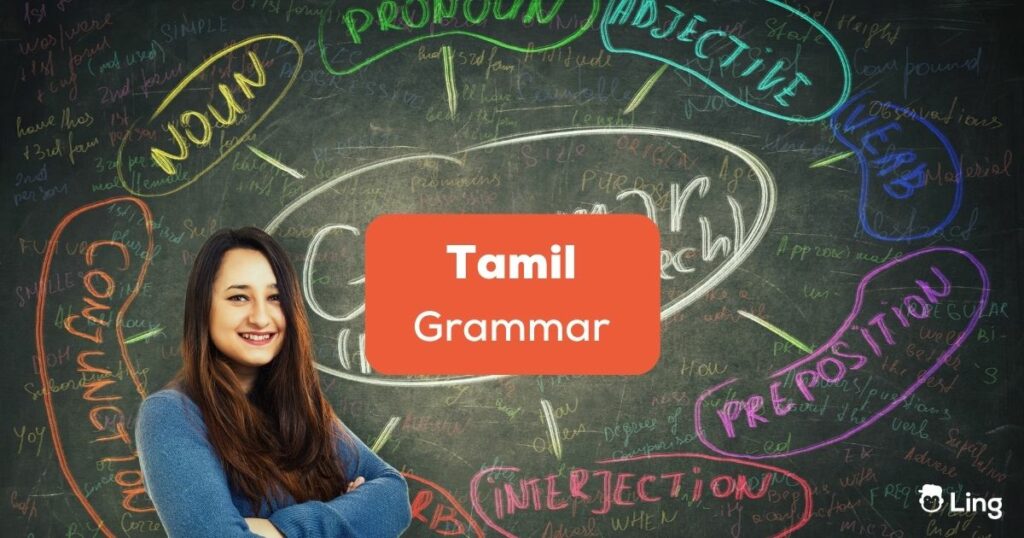Hey there! Are you a fan of the Tamil language and want to learn how to speak it like a pro? Well, buckle up, because we’re about to dive into the wacky world of Tamil grammar!
Now, before you start running for the hills, let me tell you that it is not as scary as it seems. Sure, there are a lot of rules and nuances to learn, but with a little bit of practice, you’ll be speaking like a native in no time. So put on your learning caps, grab a cup of kaapi (coffee), and get ready to have some fun with Tamil grammar!
Grammar: An Overview
Grammar is the set of rules that govern the structure and usage of any language. One of the most distinctive features of Tamil grammar is its use of agglutination. This means that words are formed by adding a suffix or prefix to the root words, resulting in long and complex words that convey a lot of meaning. For example, the word kaalam (காலம்) means time, but by adding suffixes and prefixes, we can create words like mutrilum (முற்றிலும்) which means forever. Come, let’s learn various components of grammar in the Tamil language.

Articles
Tamil does not have definite or indefinite articles like ‘the’ or ‘a’ in English. Instead, the context and the relationship between words in a sentence determine their meaning. In some cases, the language uses demonstrative pronouns, such as ‘this’ and ‘that,’ to indicate the specificity of a noun. However, most of the time, the absence of articles does not affect the clarity of the message conveyed.
Determiners
Determiners are words that precede a noun to indicate the reference of the noun in the context of the sentence. Here is a list of some commonly used determiners in Tamil:
| English | Tamil | Roman Transcription |
|---|---|---|
| One/ A/ An | ஒரு | Oru |
| This | இந்த | Inta |
| That | அந்த | Anta |
| Which | எந்த | Enta |
| Every | ஒவ்வொரு | Ovvoru |
| Some/ Few | சில | Cila |
| None | செல்லாத | Cellāta |
| How | எப்படி | Eppaṭi |
| How much | எவ்வளவு | Evvaḷavu |
| Whole/ Entire | முழு | Muḻu |
Nouns
Nouns are classified into two categories: animate and inanimate. Animate nouns are those that refer to living things, while inanimate nouns refer to non-living objects. Nouns in this language can be declined according to the eight cases, which indicate the relationship between the noun and other words in the sentence. They also have singular and plural forms, which can be created by adding suffixes or by changing the ending of the word.
Cases
Tamil has eight cases, also known as vibhaktis, which indicate the relationship between a noun and other elements in a sentence. Let’s understand each case with the help of an example.
1. Nominative Case: It is used to indicate the subject of a sentence.
For example, in the sentence nāṉ paṭikkiṟēṉ (நான் படிக்கிறேன்), nāṉ (நான்) is the subject, and it is in the nominative case. Here, nāṉ means ‘I’ and paṭikkiṟēṉ means ‘am reading.’
2. Accusative Case: It is used to indicate the direct object of a transitive verb. In other words, it is used to show the receiver of the action.
For example, in the sentence nāṉ paṭikkiṟēṉ puttakam (நான் படிக்கிறேன் புத்தகம்), puttakam (புத்தகம்) is the direct object and is in the accusative case. Here, puttakam means ‘book,’ and paṭikkiṟēṉ means ‘am reading.’
3. Instrumental Case: It is used to indicate the means or instrument with which an action is performed. It is used to answer the question ‘with what’ or ‘by what means.’
For example, in the sentence pēṉāvāl kaṭitam eḻutukiṟēṉ (பேனாவால் கடிதம் எழுதுகிறேன் – I am writing a letter with a pen), pēṉā (பேனா), meaning pen, is in the instrumental case as the means by which the action is performed.
4. Sociative Case: It is used to indicate association or companionship with someone or something. It is often used with verbs indicating actions done with someone or something else.
For example, in the sentence nāṉ naṇparuṭaṉ pōka vēṇṭum (நான் நண்பருடன் போக வேண்டும் – I want to go with a friend), naṇparuṭaṉ (நண்பருடன்) is in the sociative case as it indicates the person with whom the action of pōka, meaning ‘to go,’ is to be done. Here, nāṉ means ‘I,’ and naṇpar means ‘friend.’
5. Dative Case: It is used to show the person or thing to whom or for whom something is being done.
For example, in the sentence nāṉ eṉ cakōtaraṉukku oru putiya kār vāṅkiṉēṉ (நான் என் சகோதரனுக்கு ஒரு புதிய கார் வாங்கினேன் – I bought a new car for my brother), cakōtaraṉukku (சகோதரனுக்கு), meaning ‘to my brother’, is in the dative case as the recipient of the action.
6. Ablative Case: It is used to indicate the source or origin of something, as well as the place from where someone or something moves away. It is used to answer the questions ‘from where’ and ‘from whom.’
For example, in the sentence avaṉ mālai aḻintu vīṭukku pōṉāṉ (அவன் மாலை அழிந்து வீடுக்கு போனான் – he went home late in the evening), mālai (மாலை – evening) is in the ablative case as the source or starting point from where the person moved away.
7. Genitive Case: It is used to indicate possession or association, to answer the question ‘whose’ or ‘of what.’
For example, in the sentence avaṉuṭaiya patil eṉṉa? (அவனுடைய பதில் என்ன? – what was his answer?), avaṉuṭaiya (அவனுடைய – his) is in the genitive case as it indicates possession.
8. Locative Case: It is used to indicate the location or place where an action takes place, to answer the question ‘where.’
For example, in the sentence makaḷ pūṅkāvil amarntiruntāḷ (மகள் பூங்காவில் அமர்ந்திருந்தாள் – daughter was sitting in the park), pūṅkāvil (பூங்காவில் – in the park) is in the locative case as it indicates the location where the action of sitting takes place.

Adjectives
Adjectives are inflected based on gender, case, and number, and come before the noun they modify. For example, the adjective makiḻcciyāṉa (மகிழ்ச்சியான), meaning ‘happy,’ can be used to modify the Tamil word nāḷ (நாள் – day) to form the phrase makiḻcciyāṉa nāḷ (மகிழ்ச்சியான நாள்) which means ‘happy day.’ Adjectives can also be used in a comparative form, such as ciṟitu (சிறிது) meaning ‘less,’ and a superlative form, such as mikavum (மிகவும்) meaning ‘most.’
Pronouns
Pronouns indicate the gender, number, and case of the noun they are replacing. Tamil pronouns also include possessive pronouns and demonstrative pronouns. Here is a list:
| English | Tamil | Roman Transcription |
|---|---|---|
| I, me | நான் | Nāṉ |
| You | நீ | Nī |
| He, him | அவன் | Avaṉ |
| She, her | அவள் | Avaḷ |
| They, them | அவர்கள் | Avarkaḷ |
| We, us | நம் | Nam |
| You (plural) | நீங்கள் | Nīṅkaḷ |
| It | அது | Atu |
| This | இது | Itu |
| That | அதை | Atai |
| My, mine | என் | Eṉ |
| Your, yours | உங்கள் | Uṅkaḷ |
| Our, ours | நமது | Namatu |
| Their, theirs | அவரது | Avaratu |
| Its | அதன் | Ataṉ |
Verbs
Verbs are conjugated according to tense, aspect, mood, person, and number, which can indicate a variety of meanings and nuances. For example, the verb pēcu (பேசு – to speak) can be conjugated into the past tense as pēciṉēṉ (பேசினேன்) meaning ‘I spoke.’ Verbs in Tamil can also be transitive or intransitive, indicating whether or not they take an object. They can also be used in participial forms, such as the present participle pēcukiṟa (பேசுகிற), meaning ‘speaking.’
Adverbs
Adverbs indicate how, when, where, or to what extent an action or state occurs. For example, the adverb arumaiyāka (அருமையாக) means ‘nicely’ and can modify the verb pēcu (பேசு – speak), forming the phrase arumaiyāka pēcu (அருமையாக பேசு), which means ‘speak nicely.’ Adverbs can also indicate time, such as ippōtu (இப்போது) meaning ‘now,’ and degree, such as the adverb mika (மிக) meaning ‘very.’
Prepositions
Prepositions indicate location, direction, or time, and are used to connect nouns and pronouns with other parts of a sentence. Here is a list:
| English | Tamil | Roman Transcription |
|---|---|---|
| With | உடன் | Uṭaṉ |
| Before, in front of | முன் | Muṉ |
| After, behind | பின் | Piṉ |
| Behind, at the back of | பின்பு | Piṉpu |
| On, over, above, upon | மேல் | Mēl |
| Under, below | கீழ் | Kīḻ |
| Beside, next to | பகுதி | Pakuti |
| Inside | உள் | Uḷ |
| Outside | வெளி | Veḷi |
| Through, by means of | மூலம் | Mūlam |
| Opposite | எதிர் | Etir |
Tamil Tenses
The most common tenses in Tamil are the present, past, and future, each of which has various forms to indicate aspect and mood. For example, the present tense can be used to describe actions or states that are happening currently, such as Nāṉ cāppiṭukiṟēṉ (நான் சாப்பிடுகிறேன்) meaning ‘I am eating.’
The past tense is used to describe actions or states that have already happened, such as nāṉ cāppiṭṭēṉ (நான் சாப்பிட்டேன்) meaning ‘I ate.’ The future tense is used to describe actions or states that will happen, such as nāṉ cāppiṭuvēṉ (நான் சாப்பிடுவேன்) meaning ‘I will eat.’
Try Tamil With Ling!
Originating in Tamil Nadu, Tamil grammar is a complex and intricate system that requires a lot of dedication and practice to master. But worry not! You are in good hands with the Ling app if you wish to learn Tamil. With its gamified interface and an array of interactive, exciting, and fun exercises, the Ling app is your perfect learning guide for over 60 languages!
So, go to your Play Store or App Store and download the Ling app for free now!
























2 Responses
Your web page on learning Tamil grammar at
https://ling-app.com/ta/tamil-grammar/
has a ‘get started’ link which goes to
https://play.ling-app.com/learn?native=en&target=ta,
which is for the Thai language not the Tamil language.
Please update the link to point to the Tamil learning page.
Hi! Thank you for taking the time to leave a comment! If you are using web, the link will lead you to our Play Ling App where you can select the language you want to learn at any time. However, I recommend you downloading our app on your mobile via Play Store or App Store Give it a try 😀